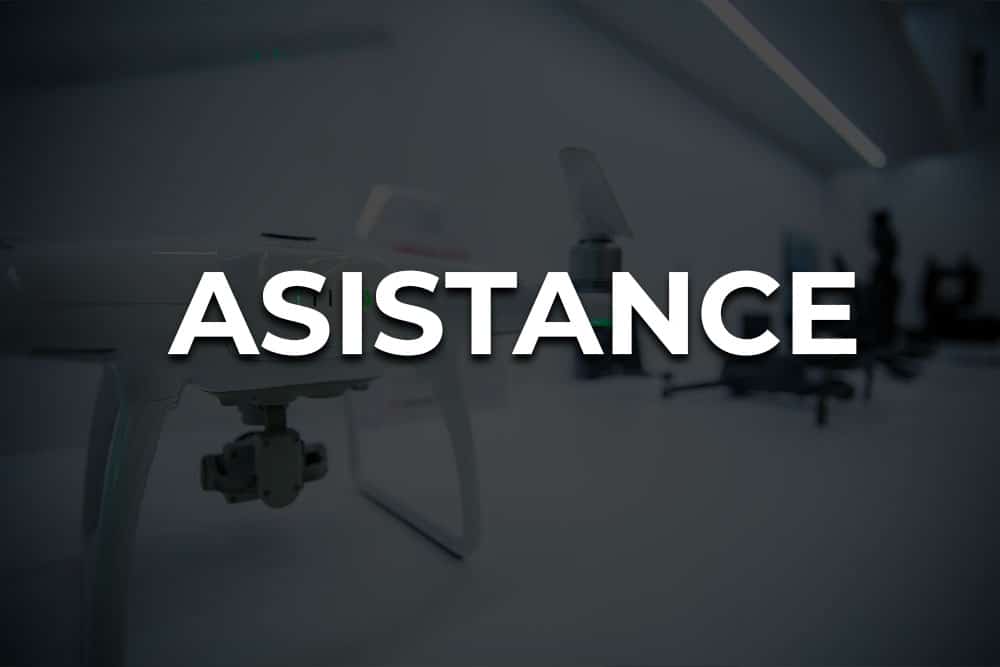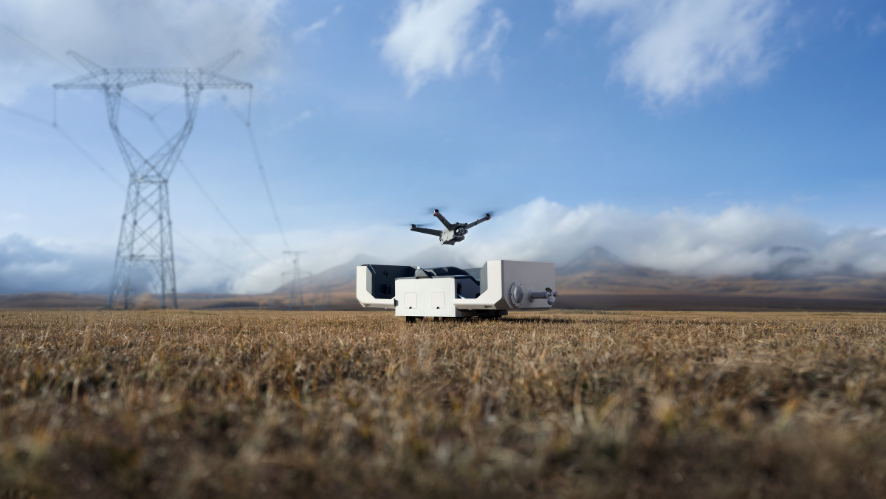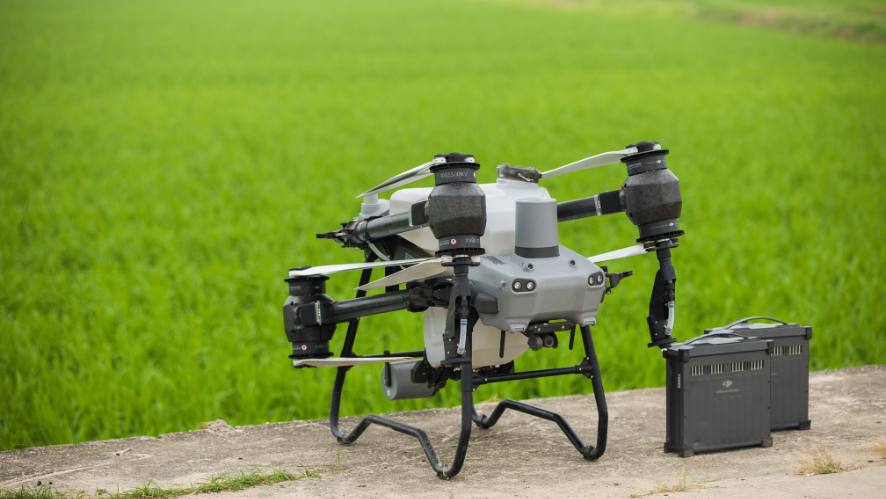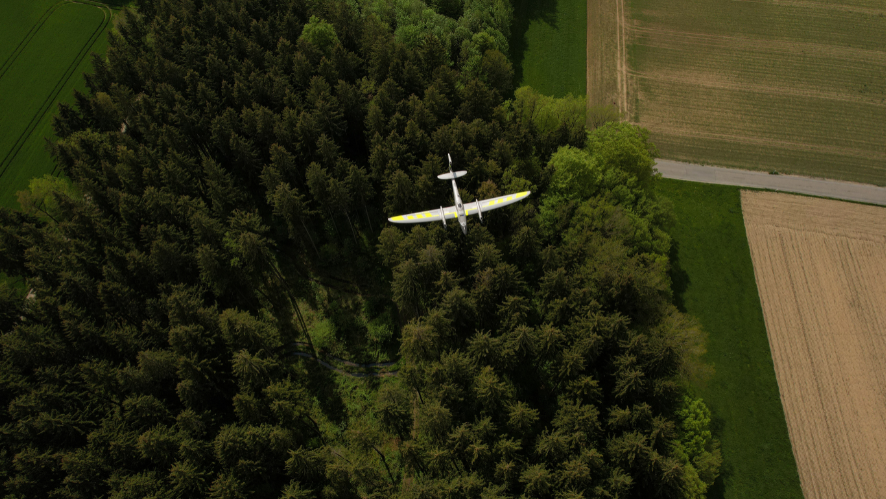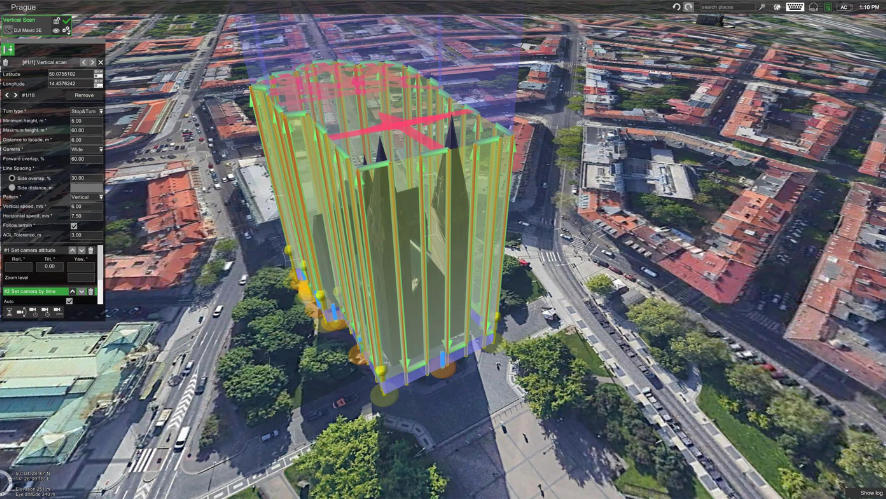DJI DOCK 2
Easy Operation, Superior Results
DJI Dock 2, a small, self-contained, high-performance platform, is equipped with the Matrice 3D/3TD drone. Not only is it light and easy to deploy, but it also has more powerful operational capabilities and intelligent cloud functions, significantly lowering the threshold for unattended operations. Efficiency and quality reach new heights.
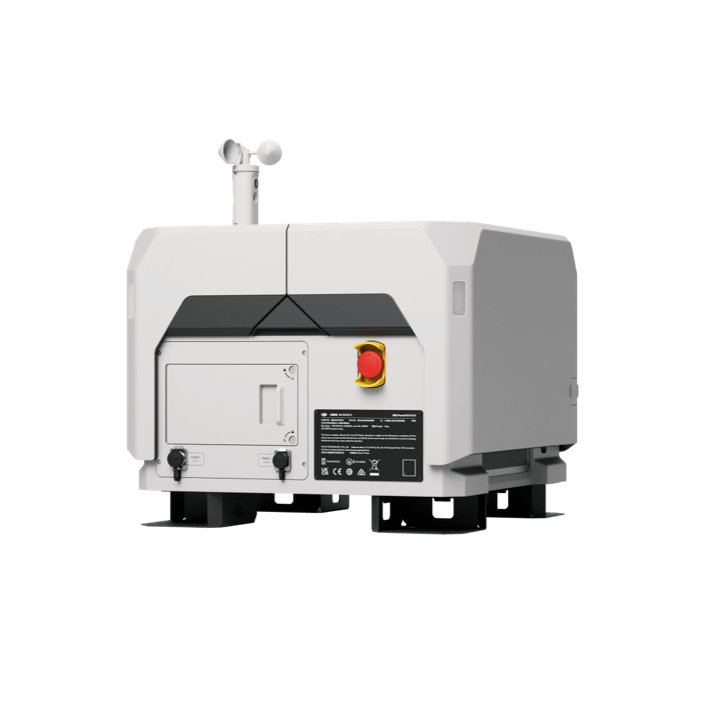

Lightweight and easy to deploy
IP55 rating
It weighs less than 34kg.
Effective maximum range of 10 km.
Private Deployment
Reliable, safe, and in service
Quick and Easy Deployment
The DJI Dock 2 stands out for its ease of deployment and quick placement. Thanks to its lightweight and compact design, with a 75% reduction in volume and a 68% reduction in weight compared to the previous generation, it can be carried by two people, significantly improving installation flexibility and reducing associated costs.
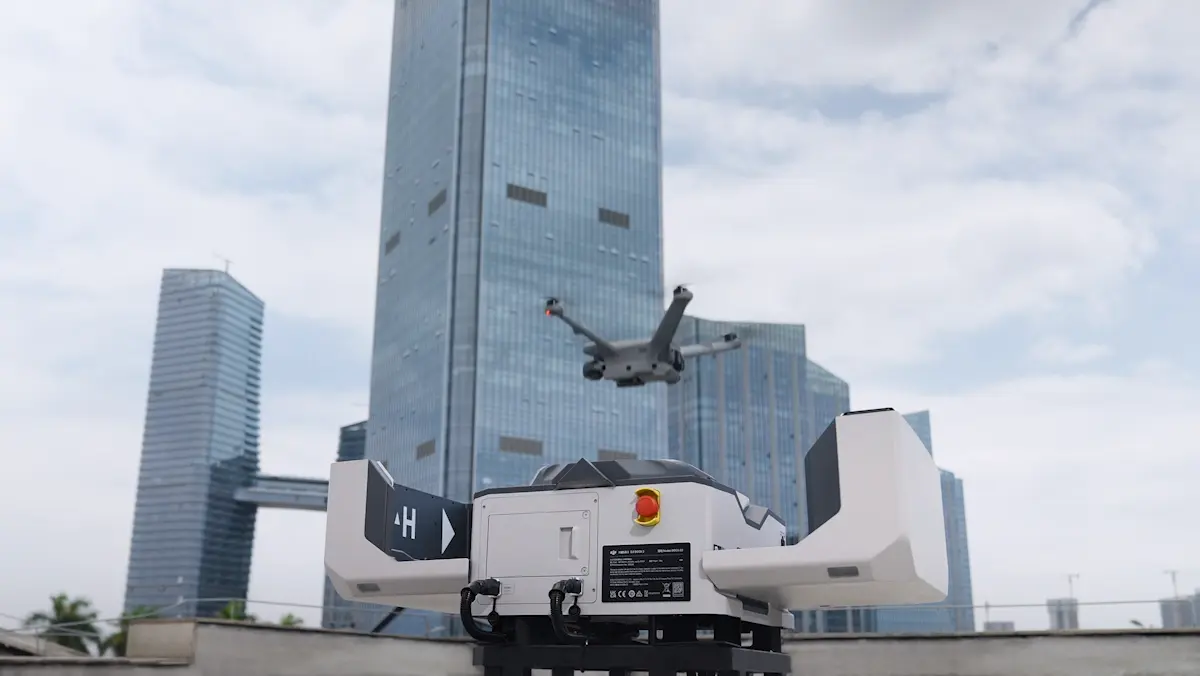
Effective terrain inspection
Before deployment, the aircraft can detect the environment using visual sensors and quickly determine if the deployment area has good GNSS signals. Compared to the original survey plan, the new visual survey plan significantly speeds up the site reading and the time required is reduced from approximately 5 hours to 12 minutes.
Once the installation is complete, operators can directly use the shared network RTK account to calibrate the dock location itself, eliminating the need for complicated operations such as purchase and login, and thus quickly obtain accurate absolute coordinates.

Reliability and security
The Dock 2 features a high protection design, with an IP55 rating and dust and water resistance capabilities. It can work steadily for a long time, even in harsh climates and environments. The platform integrates sensors like rain gauges, anemometers, and thermometers, which can detect real-time weather changes.
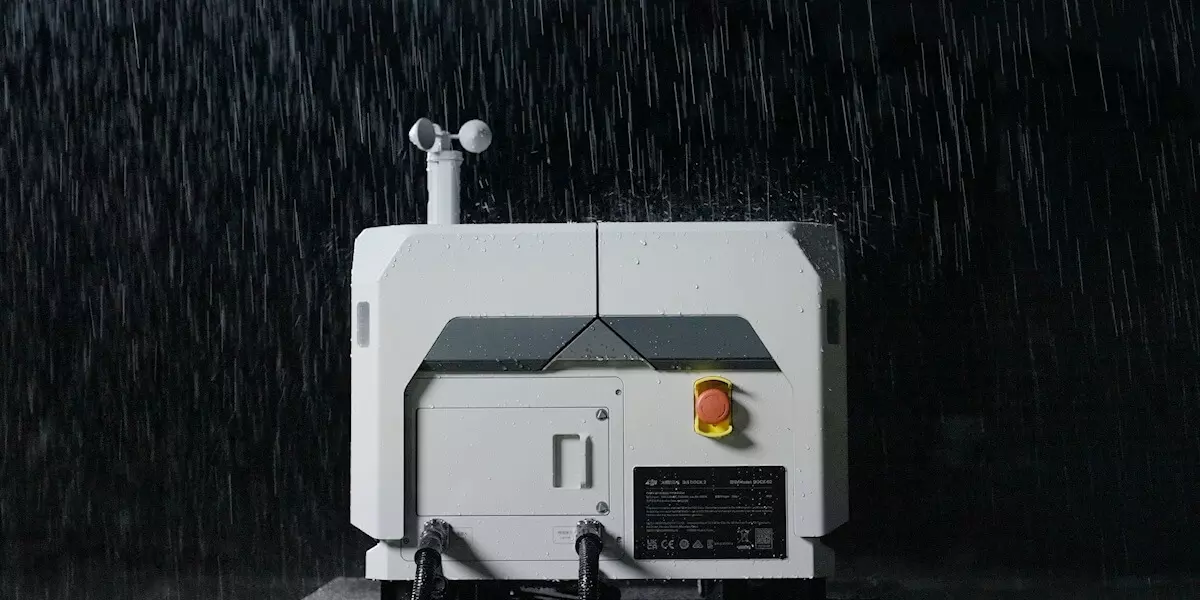
New Matrice 3D drone
The new drone has been specially designed for the DJI Dock 2. The Matrice 3D comes with a telephoto and a wide-angle camera with mechanical shutter, capable of meeting the requirements of high-precision surveying and mapping operations at 1:500 scale. The Matrice 3TD is equipped with wide-angle, telephoto and infrared cameras, which intuitively provide visible and thermal images, making it ideal for security and inspection operations.
Matrice 3D/3DT features
- IP54;
- Flying time of 50 minutes;
- Six-way obstacle avoidance system.
- Maximum range of 10 km;
- Integrated RTK module with positioning accuracy of ±3 cm;
- Battery cycles 400x.
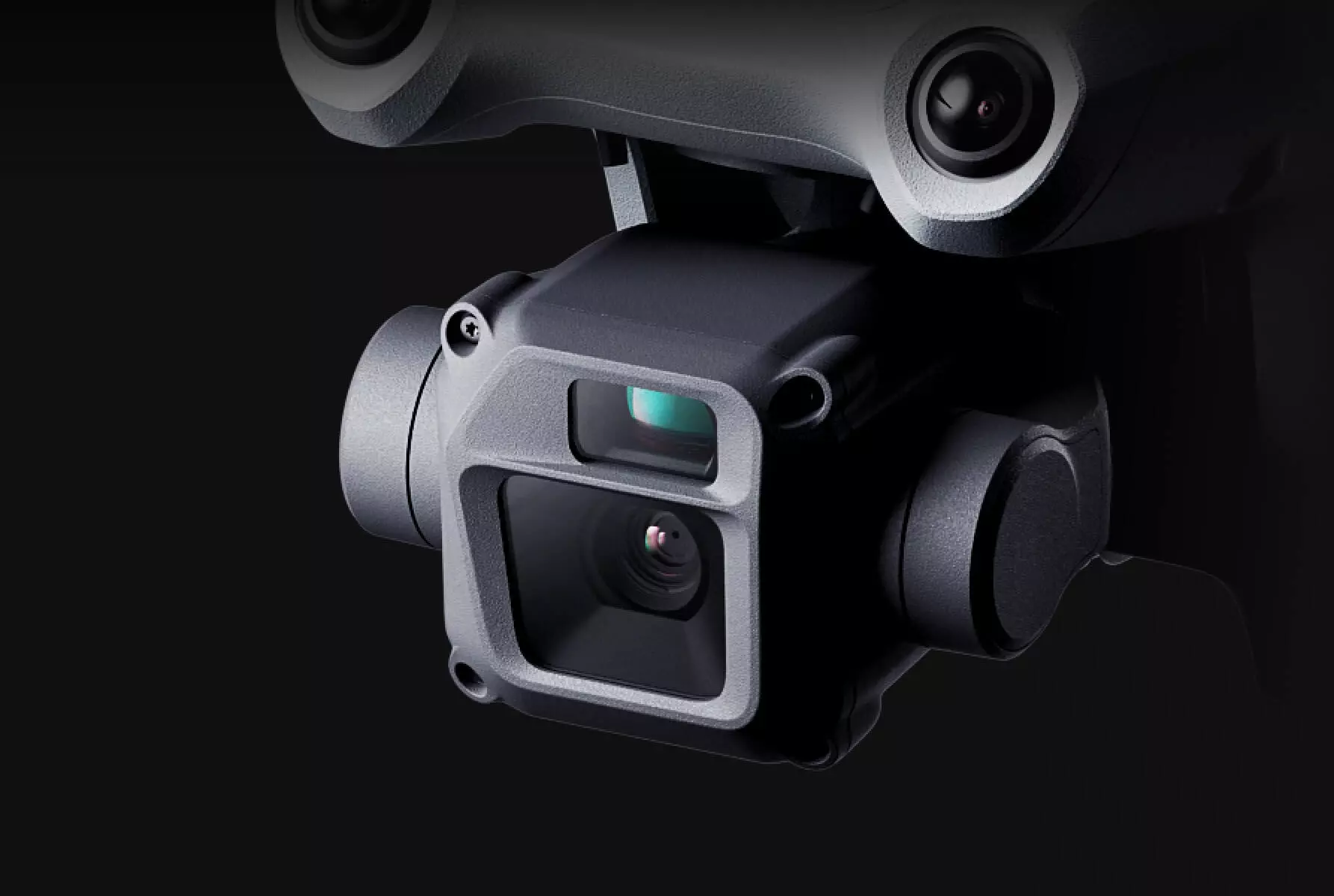
Matrice 3D
- Wide-angle camera
Focal length equivalent to 4/3 CMOS
24 mm,
20 million effective pixels,
mechanical shutter - Telephoto camera
Focal length equivalent to 1/2 inch CMOS
162 mm
12 million effective pixels
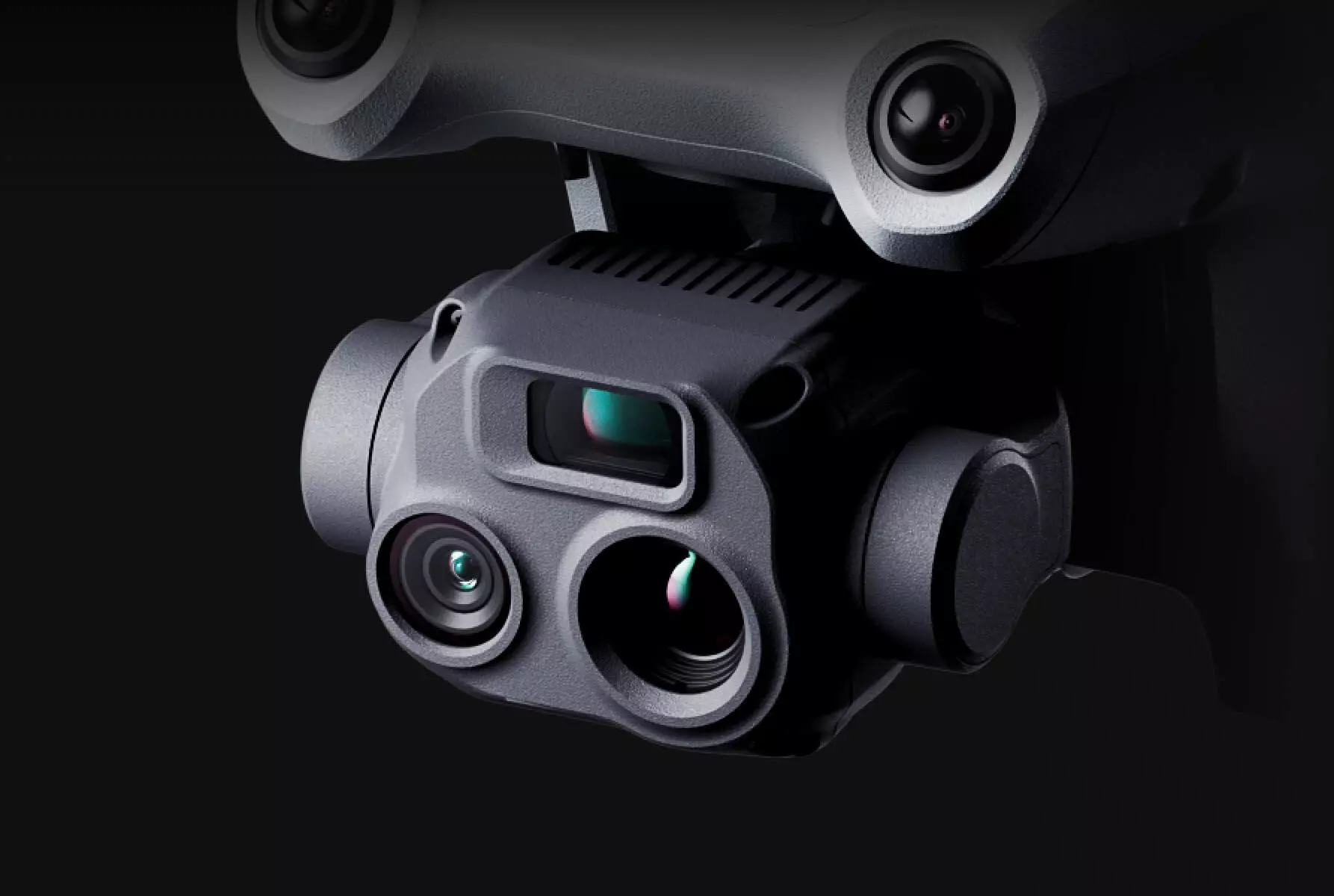
Matrice 3TD
- Wide-angle camera
CMOS equivalent focal length of 1/1.32
inch and 24 mm
48 million effective pixels - Telephoto camera
1/2 inch CMOS equivalent focal length
162 mm
12 million effective pixels - Infrared camera
Focal length equivalent to 40 mm
Normal mode: 640 × 512@30fps
Super resolution mode: 1280 × 1024@30fps
(After activating the infrared super-resolution function, the aircraft can automatically activate or deactivate the super-resolution mode depending on the brightness of the ambient light.)
28x digital zoom
Other DJI Dock 2 features
- Fast take-off (the drone can obtain accurate return position data without having to wait for synchronization with its own RTK);
- It can charge the drone quickly, from 20% to 90% in just 20 minutes;
- Two cameras, one indoor and one outdoor, are installed in Dock 2. It can provide real-time images from both sides, which helps to monitor weather conditions;
- The Matrice 3D/TD can connect to the 4G network thanks to DJI’s enhanced image transmission module. In complex environments, the 4G connection can work together with the O3 video transmission connection.
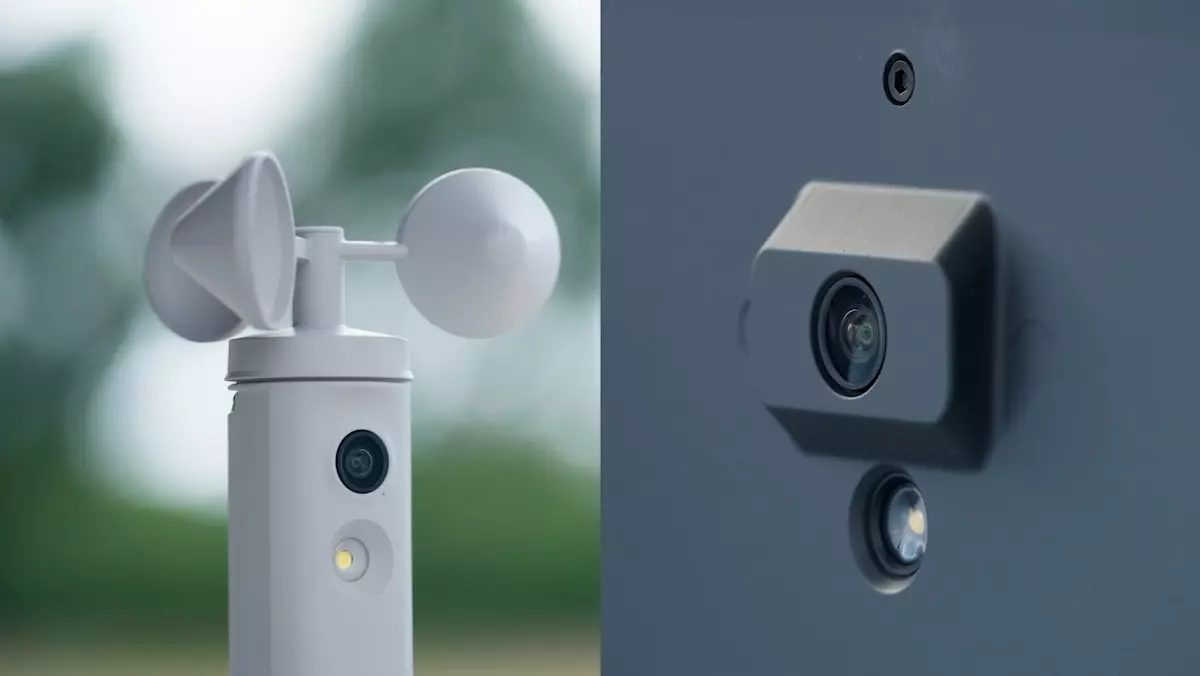
Software FlightHub 2
The DJI DOCK 2 can work with the DJI FlightHub 2 platform. Like the DJI Dock 1, the DJI DOCK 2 also supports Cloud API, which can allow third-party developers to create cloud platforms to operate/manage the DJI DOCK 2. The M3D/M3TD drone is equipped with E-Port, which can allow third-party payloads to be mounted on the aircraft.
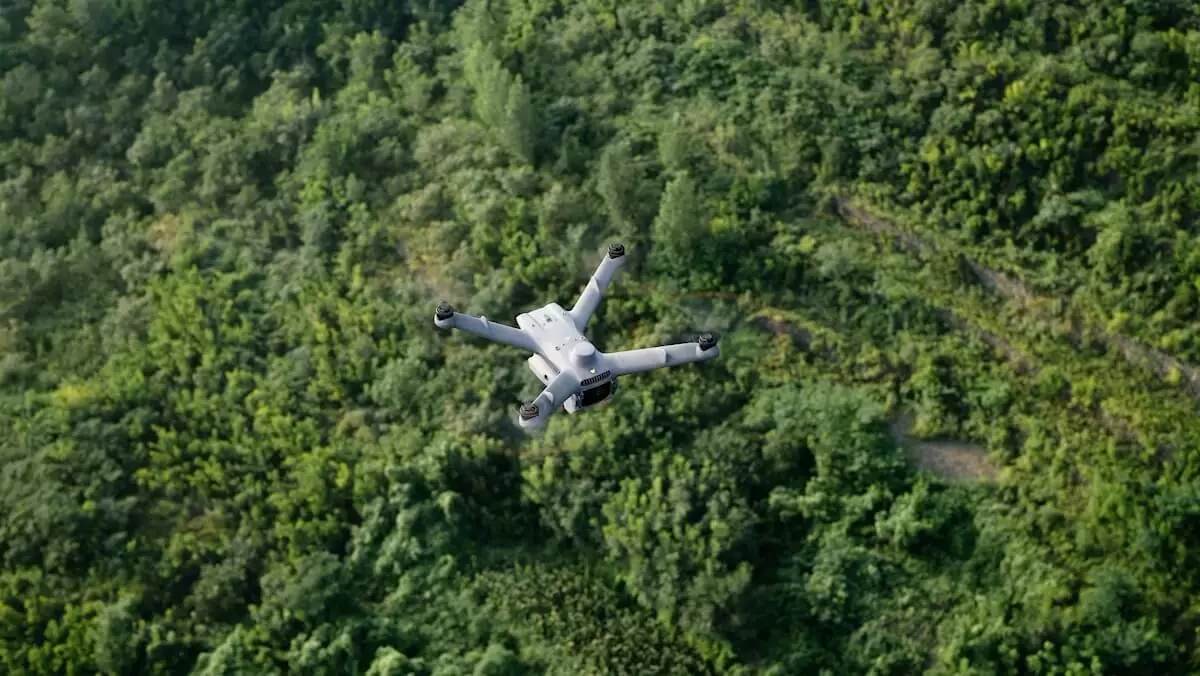
FREQUENT QUESTIONS
DOCK
What is the minimum interval DJI Dock 2 can recharge the aircraft for a second operation? Can DJI Dock 2 automatically replace the aircraft’s battery?
Measured with an ambient temperature of 25° C (77° F) and an aircraft battery level of 20% after landing, it takes 32 minutes to charge the aircraft’s battery to 90%. Therefore, the minimum interval between two operations is 32 minutes. DJI Dock 2 does not support automatic battery replacement for the aircraft.
Does DJI Dock 2 support one drone with multiple docks and one dock with multiple drones?
DJI Dock 2 does not support one dock with multiple drones. The current firmware does not support one drone with multiple docks. Please refer to the follow-up firmware update information.
Does DJI Dock 2 support edge computing?
Yes, DJI Dock 2 supports the integration of an edge computing module.
What is the maximum wind speed and rainfall in which DJI Dock 2 can continue to operate normally?
What is the maximum wind speed and rainfall in which DJI Dock 2 can continue to operate normally?
Can operators manually control the flight and gimbal angle of the aircraft through the DJI FlightHub 2 cloud platform?
Which drones does DJI Dock 2 support?
What conditions will cause the cooling function of DJI Dock 2 to be automatically enabled or disabled?
What is the media file transfer logic? Can photos, videos, and flight status be sent back in real-time?
How do I use FlyTo tasks?
What are the installation environment requirements for DJI Dock 2?
How is the precision landing of DJI Dock 2 achieved?
How does DJI Dock 2 handle unexpected power outages?
* Measured with a fully charged backup battery in a 25° C (77° F) environment.
How do I purchase DJI Dock 2?
Please contact your local DJI dealer.
AIRCRAFT
What is the difference between DJI Matrice 3D and DJI Matrice 3TD?
DJI Matrice 3D has a tele camera and a wide-angle camera with a mechanical shutter, meeting the needs for 1:500 high-precision mapping tasks. DJI Matrice 3TD, equipped with a wide-angle camera, a tele camera, and an infrared camera, can depict both visible light and thermal images, making it suitable for security and inspection operations.
What is the difference between the DJI Matrice 3D series and the DJI Mavic 3 Enterprise series?
The DJI Matrice 3D series is specifically designed for DJI Dock 2. Compared with the DJI Mavic 3 Enterprise series, it offers an increased flight time of up to 50 minutes* and features a waterproof body, a GNSS/RTK antenna, as well as lens defogging and wireless charging functions.
* Measured in a controlled test environment. Specific test conditions are as follows: flying forward at a constant speed of 46.8 kph in a windless laboratory environment at 20 meters above sea level, in photo mode (without photo-taking operation during flight), with Obstacle Avoidance Action set to Off, and from 100% battery level until 0%. Results may vary depending on the environment, actual use, and firmware version
Can I use a remote controller to manually control the DJI Matrice 3D series?
Once the DJI RC Pro Enterprise and DJI Matrice 3D series are paired, users can proceed with manual control.
Can the DJI Matrice 3D series be used with other docks?
No. It can only be used with DJI Dock 2.
Does the tele camera on DJI Matrice 3D support mapping without GCPs?
Are the DJI Mavic 3 Enterprise series accessories compatible with the DJI Matrice 3D series?
Does the DJI Matrice 3D series support Hyperlapse, ActiveShots, and Timelapse?
No.
Does the DJI Matrice 3D series support precision mapping?
DJI Matrice 3D can meet the requirements of 1:500 high-precision mapping operations. If DJI Matrice 3TD is used for mapping operations, the model accuracy cannot meet the high-precision mapping requirements, so DJI Matrice 3D is recommended instead.
What precautions should be taken when using the infrared camera of DJI Matrice 3TD?
Do not expose the infrared camera lens to strong sources of energy, such as the sun, lava, or laser beams. Otherwise, the camera sensor may be burned, leading to permanent damage.
Can I use the DJI Matrice 3D series across countries or regions?
No. Please confirm the applicable countries and regions with your dealer before purchasing.
Does the DJI Matrice 3D series support the installation of third-party payloads?
Equipped with an E-Port, the aircraft supports connection to third-party payloads like loudspeakers and spotlights to achieve more functions. Moreover, the E-Port Lite on the aircraft supports the connection of a parachute, effectively ensuring flight and personnel safety.
Loudspeakers, spotlights, parachutes, and other third-party payloads are sold separately.
Why do the propellers of the DJI Matrice 3D series rotate slowly before takeoff?
Before takeoff, the DJI Matrice 3D series will slowly rotate the propellers for a few seconds. During this rotation process, the aircraft will check the integrity of the propellers through the lenses. If there is any damage larger than 10 mm on the propellers, the takeoff will be suspended to ensure flight safety.
Why do I hear a sound coming from the frame arms when I shake the DJI Matrice 3D series?
SPECIFICATIONS
DJI DOCK 2
|
Total weight
|
34 kg
|
||||||
|
Dimensions
|
Dock cover open: 1228 × 583 × 412 mm (L × W × H) The above data does not include the height of the wind speed gauge (145 mm) but includes the height of the mounting base brackets (55 mm). |
||||||
| Input voltage |
100-240 VAC, 50-60 Hz
|
||||||
| Maximum input power |
1.000 W
|
||||||
|
Operating temperature
|
–De −25 a 45 °C (de −13 a 113 °F)
When the ambient temperature is below -20° C (-4° F), the dock is in standby status, and the aircraft cannot perform flight tasks.
|
||||||
| Ingress Protection Rating |
IP55
|
||||||
|
Number of Drones Accommodated
|
1
|
||||||
| Maximum permissible wind speed for landing | 8 m/s | ||||||
| Maximum operating altitude | 4000 m | ||||||
| RTK base station satellite reception frequency | Receive simultaneously: GPS: L1 C/A, L2 BeiDou2: B1l, B2l, B3l BeiDou3: B1l, B3l GLONASS: L1, L2 Galileo: E1, E5B |
||||||
| RTK base station positioning accuracy | Horizontal: 1 cm + 1 ppm (RMS) Vertical: 2 cm + 1 ppm (RMS) |
||||||
CHARGING PERFORMANCE
| Output voltage | 28 V CC | ||||||
| Charging Time |
32 minutes The data was measured when charging the aircraft (when powered off) from 20% to 90% in a 25° C (77° F) environment. |
||||||
VIDEO TRANSMISSION
| Video transmission system | 03 Enterprise | ||||||
| Operating frequency | 2.4000-2.4835 GHz 5.725-5.850 GHz |
||||||
|
Antennas
|
Built-in 4 antennas, 2T4R, supports intelligent switching | ||||||
| Transmitter power (EIRP) | 2.4 GHz: <33 dBm (FCC); <20 dBm (CE/SRRC/MIC) 5.8 GHz: <33 dBm (FCC); <14 dBm (CE); <23 dBm (SRRC) |
||||||
AIR CONDITIONING SYSTEM
| Operating voltage | 28 V CC | ||||||
| Type of air conditioner | TEC air conditioner | ||||||
BACKUP BATTERY
| Load capacity | 12 Ah | ||||||
| Output voltage | 12 V | ||||||
| Battery type | Lead-acid battery | ||||||
| Battery Life |
>5 hours Measured with a fully charged backup battery in a 25° C (77° F) environment. After a power outage, the dock does not support functions like aircraft charging, air conditioning, dock cover heating, and wind speed gauge heating. Always check malfunctions promptly. |
||||||
NETWORK ACCESS
| Ethernet Access | 10/100/1000 Mb/s adaptable Ethernet port | ||||||
SENSOR
| Wind speed sensor | Compatible | ||||||
| Precipitation sensor | Compatible | ||||||
| Ambient temperature sensor | Compatible | ||||||
| Water immersion sensor | Compatible | ||||||
| Cabin temperature sensor | Compatible | ||||||
| Humidity sensor in cabin | Compatible | ||||||
SECURITY CAMERA (EXTERNAL)
| Resolution | 1920×1080 | ||||||
| Field of view (FOV) | 151° | ||||||
|
Auxiliary Light
|
Auxiliary Light | ||||||
SECURITY CAMERA (INTERNAL)
| Resolution | 1920×1080 | ||||||
| Field of view (FOV) | 151° | ||||||
|
Auxiliary Light
|
Auxiliary Light | ||||||
LIGHTNING PROTECTION
| AC power port |
20 kA (rated value), meets EN 61643-11 Type 2 and IEC 61643-1 Class Ⅱ protection level requirements
|
||||||
| Mains connection | 10 kA (Itotal), meets EN/IEC 61643-21 protection level requirements Category C | ||||||
COMPATIBLE SOFTWARE
|
Applications
|
DJI Pilot 2 (connects to DJI Dock 2 via DJI RC Pro Enterprise for deployment and commissioning) | ||||||
|
Cloud Platform
|
DJI FlightHub 2 (supported by default) Third-party cloud platforms (accessed via DJI cloud APIs) |
||||||
EXPANSION CAPABILITY
| Open protocol | DJI Cloud API | ||||||
| Edge computing | Supports data communication with external switches | ||||||
AERONAVE – GENERAL
| Weight |
1410 g This value includes the weight of the battery, propellers, and a microSD card, but does not include third-party payloads. The actual product weight may vary due to differences in batch materials and external factors. |
| Maximum take-off weight | 1610 g |
| Dimensions | 335 × 398 × 153 mm (l. × w. × h.) |
| Wheelbase | Diagonal distance between axles: 463.2 mm (463.2 in.) Wheelbase left-right: 359.9 mm (1.5 in.) Front-to-rear wheelbase: 291.4 mm (291.4 in.)Distancia entre ejes |
| Maximum ascent speed | 6 m/s (Normal mode) 8 m/s (Sport mode) |
| Maximum descent speed | 6 m/s (Normal mode) 6 m/s (Sport mode) |
| Maximum horizontal speed (at sea level, no wind) | Normal mode, with obstacle detection enabled: 15 m/s flying forward, 12 m/s flying backward, 10 m/s flying sideways Sport mode: 21 m/s flying forward, 18 m/s flying backward, 16 m/s flying sideways |
| Maximum wind resistance | During operation: 12 m/s During take-off/landing: 8 m/s |
| Maximum takeoff altitude | 4000 m |
| Maximum flight time |
50 minutes Measured in a controlled test environment. Specific test conditions are as follows: flying forward at a constant speed of 46.8 kph in a windless laboratory environment at 20 meters above sea level, in photo mode (without photo-taking operation during flight), with Obstacle Avoidance Action set to Off, and from 100% battery level until 0%. Results may vary depending on the environment, actual use, and firmware version |
| Max Hovering Time |
40 minutes Measured with the DJI Matrice 3D series drones hovering in a windless environment at 20 meters above sea level and from 100% battery level until 0%. Results may vary depending on the environment, actual use, and firmware version |
| Max Operating Radius |
10 km Measured in an environment of approximately 25° C (77° F) with a safe battery level of 25%, ambient wind speed of approximately 4 m/s, round-trip flight speed of approximately 15 m/s, and hovering operation of 10 minutes. Results may vary depending on the environment, actual use, and firmware version |
| Max Flight Distance |
43 km Measured with DJI Matrice 3D/3TD flying at a constant speed of 54 kph in a windless environment at 20 meters above sea level and from 100% battery level until 0%. Results may vary depending on the environment, actual use, and firmware version |
| Maximum tilt angle | 25° (Normal mode) 25° (Sport mode) |
| Maximum angular velocity | 250°/s |
| Global Navigation Satellite Systems | GPS + Galileo + BeiDou + GLONASS (GLONASS is only supported when RTK module is activated) |
| Hovering Accuracy Range (windless or breezy) |
Vertical: Horizontal: |
| Operating temperature | -20 to 45 °C (-4 to 113 °F) |
| Ingress protection rating | IP54 |
| Engine model | 2607 |
| Propeller model | 1149, folding, without quick release |
| RTK module | Integrated in the aircraft |
| Beacon | Integrated in the aircraft |
AIRCRAFT – WIDE-ANGLE CAMERA
| Image Sensor | DJI Matrice 3D: 4/3 CMOS; effective pixels: 20 MP DJI Matrice 3TD: 1/1.32-inch CMOS; effective pixels: 48 MP |
| Lens |
DJI Matrice 3D DJI Matrice 3TD |
| Lens fogging | DJI Matrice 3D: Wide-angle camera provides lens defogging.<br> DJI Matrice 3TD: Wide-angle camera offers lens defogging. |
| ISO Range | DJI Matrice 3D: 100-6400 DJI Matrice 3TD: 100-25 600 |
| Shutter Speed |
DJI Matrice 3D DJI Matrice 3TD |
| Maximum image size | DJI Matrice 3D: 5280×3956 DJI Matrice 3TD: 8064×6048 |
| Still photography modes |
DJI Matrice 3D DJI Matrice 3TD *The 0.7s and 1s intervals are not supported when taking 48MP timed photos. |
| Video resolution | H.264 4K: 3840×2160 a 30 fps FHD: 1920×1080 a 30 fps |
| Video Bitrate |
DJI Matrice 3D DJI Matrice 3TD |
| Supported file system | exFAT |
| Photo format | JPEG |
| Video format | MP4 (MPEG-4 AVC/H.264) |
AIRCRAFT – TELE CAMERA
| Image sensor | 1/2-inch CMOS; effective pixels: 12 MP |
| Lens | Field of view: 15°. Equivalent format: 162 mm Aperture: f/4.4 Focus: From 3 m to ∞ |
| Lens defogging | DJI Matrice 3D: The camera offers lens defogging. DJI Matrice 3TD: The camera offers lens defogging |
| ISO Range | DJI Matrice 3D: 100-6400 DJI Matrice 3TD: 100-25 600 |
| Shutter speed | Electronic shutter: 8/1-8000 s |
| Maximum image size | 4000×3000 |
| Photo format | JPEG |
| Video format | MP4 (MPEG-4 AVC/H.264) |
| Still photography modes |
DJI Matrice 3D DJI Matrice 3TD |
| Video resolution | H.264 4K: 3840×2160 a 30 fps FHD: 1920×1080 a 30 fps |
| Video Bitrate |
DJI Matrice 3D DJI Matrice 3TD |
AIRCRAFT – INFRARED
| Digital zoom | 8x (56x hybrid zoom) |
| Thermograph | Uncooled VOx microbolometer |
| Pixel Pitch | 12 μm |
| Frame rate | 30 Hz |
| Lens |
Field of view: 61°. Do not expose the infrared camera lens to strong sources of energy, such as the sun, lava, or a laser beam. Otherwise, the camera sensor may be burned, leading to permanent damage. |
| Sensitivity | ≤50 mK at F1.0 |
| Temperature measurement method | Spot measurement, area measurement |
| Temperature measuring range | -20 to 150 °C (-4 to 302 °F, high gain mode) 0 to 500 °C (32 to 932 °F, low gain mode) |
| Palette | Vivid White/Vivid Black/Dye/Red Iron/Hot Iron/Hot Iron/Arctic/Medical/Fulgurite/Rainbow 1/Rainbow 2 |
| Photo format | R-JPEG (8 bits)<br> R-JPEG (16 bits) |
| Video Resolution | Normal mode: 640×512 at 30 fps UHR Infrared Imaging Mode: 1280×1024 at 30 fps (With UHR Infrared Imaging enabled, the aircraft can automatically enable and disable UHR Infrared Imaging Mode according to the brightness of ambient light). |
| Video bit rate | 6 Mb/s |
| Video format | MP4 (MPEG-4 AVC/H.264) |
| Still photography modes |
Single shot< With timer |
| Digital zoom | 28× |
| Infrared wavelength | 8-14 μm |
| Infrared temperature measurement accuracy | ±2 °C or ±2 % (using the higher value) |
AIRCRAFT – GIMBAL
| Stabilization | 3-axis mechanical stabilizer (tilt, rotation and pan) |
| Mechanical range | Tilt: -135 to +45 °C (-135 to +45 °C) Rotation: -45 to +45 °C (-45 to +45 °C) Pan: -27 to +27 °C (-27 to +27 °C) |
| Controllable range | Tilt: -90 to +35 °C (-90 to +35 °F) Pan: Not controllable |
| Maximum control speed (inclination) | 100°/s |
| Angular vibration range | ±0.005° |
AIRCRAFT – SENSING
| Sensing Type | The aircraft can detect obstacles in six directions. The aircraft has a 10° blind spot in the upper rear area. Always fly with caution. |
| Forward | Measuring range: 0.5-21 m Detection range: 0.5-200 m Effective detection speed: Flying speed ≤15 m/s Field of view: 90° horizontal, 90° vertical |
| Backward | Measurement range: 0.5-23 m Effective detection speed: Flying speed ≤12 m/s Field of view: 90° horizontal, 90° vertical |
| Lateral | Measurement range: 0.5-15 m Effective detection speed: Flying speed ≤10 m/s Field of view: 104° horizontal, 90° vertical |
| Upward | Measurement range: 0.5-21 m Effective detection speed: Flying speed ≤6 m/s Field of view: 90° front and rear, 90° left and right. |
| Downward | Measurement range: 0.5-14 m Effective detection speed: Flying speed ≤6 m/s Field of view: 95° front and rear, 110° left and right. |
| Operating environment | Front, rear, left, right and top: Surfaces with recognizable patterns and adequate illumination (lux > 15) Lower: Surface with diffuse reflectivity > 20 % (p. ej., walls, trees, people) and adequate lighting (lux > 15) |
AIRCRAFT – VIDEO TRANSMISSION
| Video Transmission System | DJI O3 Enterprise Transmission |
| Live view quality | 720p/30 fps, 1080p/30 fps (with DJI RC Pro Enterprise) 540p/30 fps, 720p/30 fps, 1080p/30 fps (with DJI FlightHub 2) |
| Operating Frequency |
2.4000-2.4835 GHz In some countries and regions, the 5.1GHz and 5.8GHz frequency bands are prohibited, or the 5.1GHz frequency band is only allowed for indoor use. Please refer to local laws and regulations for more information. |
| Max Transmission Distance (unobstructed, free of interference) |
DJI Matrice 3D DJI Matrice 3TD Measured in an unobstructed outdoor environment free of interference. The above data shows the farthest communication range for one-way, non-return flights under each standard. Always pay attention to RTH reminders in DJI FlightHub 2 during your flight. |
| Max Transmission Distance (unobstructed, with interference) |
Strong interferences (urban centers, residential areas, etc.): 1.5-3 km (FCC/CE/SRRC/MIC) Measured with the aircraft flying (without third-party payloads) in unobstructed environments with typical interference. The above data shows the farthest communication range for one-way, non-return flights under each standard. Always pay attention to RTH reminders in DJI FlightHub 2 during your flight. |
| Max Download Speed |
5 MB/s (with DJI Dock 2) Measured in a laboratory environment with little interference in countries/regions that support both 2.4 GHz and 5.8 GHz. Download speeds may vary depending on the actual conditions. |
| Minimum latency | Video transmission latency from the aircraft to the Dock is approximately 110 to 150 milliseconds (environmental conditions influence). Network conditions and computer configuration influence the video transmission latency from the Dock to DJI FlightHub 2. |
| Antenna | 4 antennas, 2T4R |
| Transmitter Power (EIRP) | 2.4 GHz: <33 dBm (FCC), <20 dBm (CE/SRRC/MIC) 5.1 GHz: <23 dBm (CE) 5.8 GHz: <33 dBm (FCC/SRRC), <14 dBm (CE) |
AIRCRAFT – STORAGE
| Supported Memory Cards | Aircraft: U3/Class 10/V30 or higher are supported. A list of recommended microSD cards can be found below. |
| Recommended microSD Cards3 | Aircraft: SanDisk Extreme 32GB V30 A1 microSDHC SanDisk Extreme PRO 32GB V30 A1 microSDHC SanDisk Extreme 512GB V30 A2 microSDXC Lexar 1066x 64GB V30 A2 microSDXC Kingston Canvas Go! Plus 64GB V30 A2 microSDXC Kingston Canvas React Plus 64GB V90 A1 microSDXC Kingston Canvas Go! Plus 128GB V30 A2 microSDXC Kingston Canvas React Plus 128GB V90 A1 microSDXC Kingston Canvas React Plus 256GB V90 A2 microSDXC < Samsung PRO Plus 256GB V30 A2 microSDXC |
AIRCRAFT – BATTERY
| Capacity | 7811 mAh |
| Voltage | 14.76 V |
| Max. load voltage | 17.0 V |
| Type | Li-ion 4S |
| Chemical system | LiNiMnCoO2 |
| Energy | 115.2 Wh |
| Weight | 544 g |
| Cycle count | 400 |
| Loading temperature | 5 to 45 °C (41 to 113 °F) |
AIRCRAFT – POWER ADAPTER
| Input | 100-240 V (CA), 50/60 Hz, 2.5 A |
| Power output | 100 W |
| Output |
Max output power of 100 W (total) When both ports are used, the power adapter will dynamically allocate the output power of the two ports according to the load power, and the maximum output power of one of the ports is 82 W. |
AIRCRAFT – CHARGING BASE
| Input | USB-C: 5-20 V, 5.0 A |
| Output | Battery port: 12-17 V, 8.0 A |
| Power rating | 100 W |
| Type of charging | Batteries are charged one at a time |
| Charging temperature | 5 to 40 °C (41 to 104 °F) |
COMPARISON OF DJ MATRICE 3D, 3T and 30T SPECIFICATIONS
| M3TD | M3T | M30T DOCK VERSION | |
| WEIGHT | 1410 g | 920 g | 3870 g |
| DIMENSIONS (Unfolded) | 335x398x153mm | 347.5x283x107.7mm | 470x585x246mm |
| MAX HORIZONTAL SPEED | 21 m/s | 21 m/s | 23 m/s |
|
MAX WIND SPEED WIND RESISTANCE
|
During operation:12 m/s |
12 m/s |
12 m/s |
| takeoff/land:8 m/s | |||
| MAX TIEMPO DE VUELO | 50 min | 45 min | 40 min |
| TIEMPO MÁXIMO DE VUELO ESTACIONARIO | 40 min | 38 min | 35 min |
| TASA IP | IP54 | not supported | IP55 |
| TEMPERATURE | -20°C ~ 45 °C | -10°C ~ 40°C | -20°C ~ 50 °C |
| WIDE CAMERA | 1/1.32″ CMOS,48MP | 1/2″ CMOS,48MP | 1/2″ CMOS,12MP |
|
ZOOM CAMERA
|
1/2″ CMOS,12MP |
1/2″ CMOS,12MP |
1/2″ CMOS,48MP |
| 56x hybrid | 56x hybrid | 5x-16x optical zoom | |
| THERMAL CAMERA | 640×512@30fps | 640×512@30fps | 640×512@30fps |
| LASER MODULE | not supported | not supported | supported |
| FPV CAMERA | not supported | not supported | supported |
COMPARISON OF DJI DOCK 1 AND DJI DOCK 2 SPECIFICATIONS
| DOCK2 | DOCK1 | |
| PESO | 34 kg | 105kg |
|
DIMENSIONS
. |
dock opened:1228*583*412mm |
dock opened:570*583*465mm |
| dock closed:570*583*465mm | dock open:800x885x1065mm | |
| INPUT VOLTAGE | 100 ~ 240 V(corriente alterna),50/60 Hz | 100 ~ 240 VAC,50/60 Hz |
| INPUT POWER | max 1000 W | max 1500 W |
| TEMPERATURE | -25°C ~ 45°C | -35°C ~ 50°C |
| TASA IP | IP55 | IP55 |
| ALTITUD MÁXIMA DE DESPEGUE | 2500 m | 4000 m |
| RADIO MÁXIMO DE OPERACIÓN | 10 km | 7 km |
| CARGA | 32min(20%-90%) | 25min(10%-90%) |
| BATTERY CYCLE | 400 cycles | 400 cycles |
| BACKUP BATTERY | more than 5 hours | more than 5 hours |
| UNRAVELING | cloud API+edge computing | cloud API+edge computing |
| SURVEILLANCE CAMERA | automatic dual camera switch | single camera |



